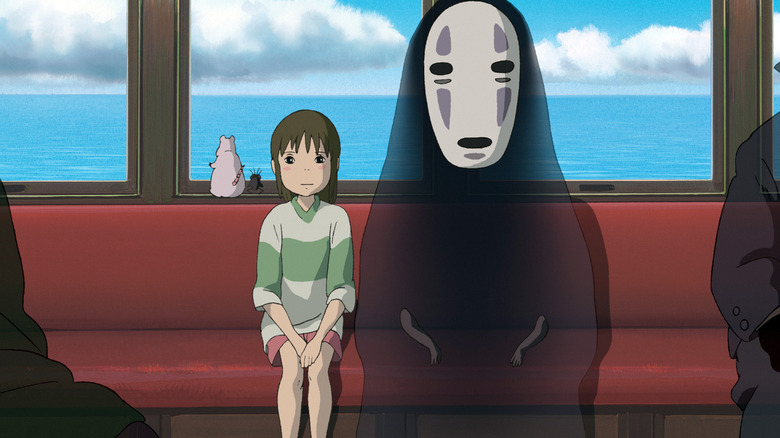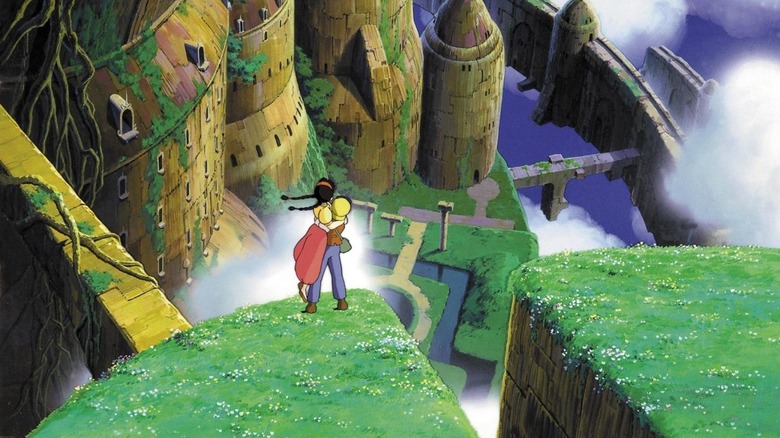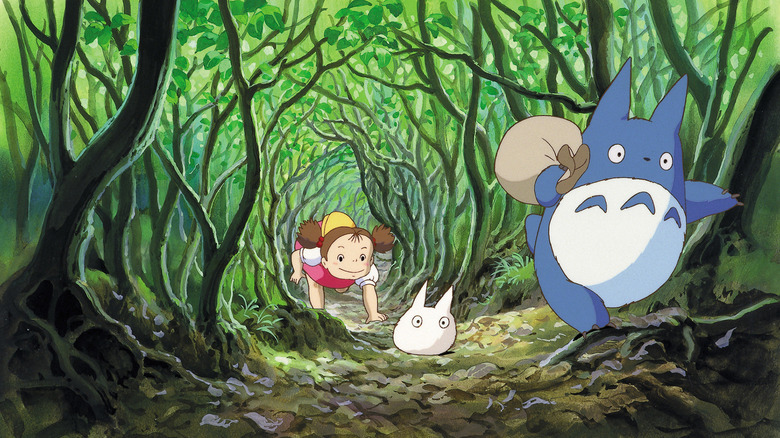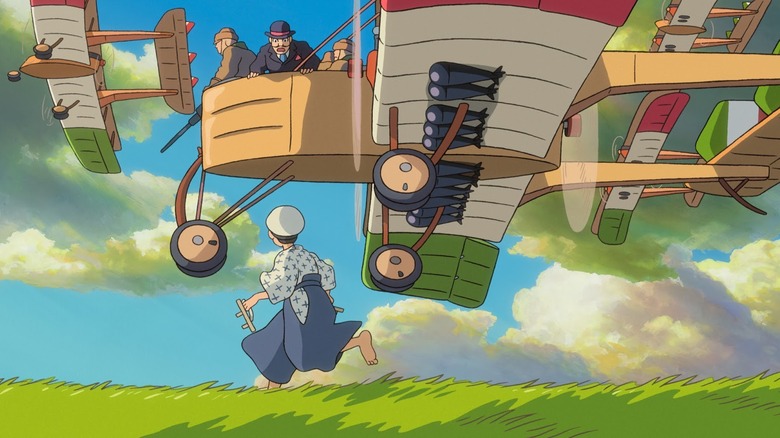Studio Ghibli's Scripting Process Is Practically Nonexistent
The very first film produced under the Studio Ghibli banner was Hayao Miyazaki's "Castle in the Sky" in 1986. Miyazaki's screenplay was based partly on Jonathan Swift's 1726 novel "Gulliver's Travels," which featured a floating island called Laputa populated by a people known as the Balnibarbi, who have devoted their lives to academics and the arts. In keeping with Swift's satirical nature, the Balnibarbi were also completely useless, having found no practical use for their studies. Miyazaki depicted Laputa has having long been abandoned, now only overseen by rusty, ancient robots. Miyazaki told most of Laputa's story through its design, and was careful to include visual references to multiple ancient Earth cultures on the floating island's walls.
Miyazaki's visual approach to storytelling became pervasive throughout his work, and the directors at Studio Ghibli — including Isao Takahata, Yoshifumi Kondō, Hiromasa Yonebayashi, and Miyazaki's son, Goro Miyazaki — are largely known for their ability to slow down their films by carefully including quiet moments and incidental domestic action. Indeed, slow action, tone, atmosphere, and visual communication are so strong in Ghibli films it may not come as a surprise that most of the studio's productions are storyboarded prior to being scripted.
In a 2002 interview with Midnight Eye, Miyazaki explained Ghibli's filmmaking process, and how the stories to his movies are discovered during the process.
That's the way I work
Hayao Miyazaki is apologetic about his preferred filmmaking process. Traditionally, an animated film is scripted first, with audio recording and design and storyboarding happening after. Miyazaki storyboards his film first, sans script. This must be aggravating for his team of animators, which Miyazaki acknowledged to Midnight Eye:
"That's true. I don't have the story finished and ready when we start work on a film. I usually don't have the time. So the story develops when I start drawing storyboards. The production starts very soon thereafter, while the storyboards are still developing. We never know where the story will go but we just keeping working on the film as it develops. It's a dangerous way to make an animation film and I would like it to be different, but unfortunately, that's the way I work and everyone else is kind of forced to subject themselves to it."
When asked if his script-less approach to filmmaking was due to a more intense focus on the more intimate part of storytelling, like character or empathy, he became surprisingly technical:
"What matters most is not my empathy with the characters, but the intended length of the film. How long should we make the film? Should it be two hours long or three? That's the big problem. I often argue about this with my producer and he usually asks me if I would like to extend the production schedule by an extra year. In fact, he has no intention of giving me an extra year, but he just says it to scare me and make me return to work. I really don't want to be a slave to my work by working a year longer than it already takes, so after he says this I usually return to work with more focus and at a much faster pace."
It's notable that Miyazaki has never made a three-hour film, and Studio Ghibli's longest to date is Isao Takahata's 2013 film "The Tale of the Princess Kaguya," which runs 137 minutes.
Nothing goes to waste
It seems that Hayao Miyakzaki prefers this mode of storytelling as a means of achieving efficiency. Rather than workshop ideas to death, Miyazaki wants to include everything. He creates carefully as to not to have to shorten or edit things out later in the process. Miyazaki continued to Midnight Eye:
"Another principle I adhere to when directing, is that I make good use of everything my staff creates. Even if they make foregrounds that don't quite fit with my backgrounds, I never waste it and try to find the best use for it."
Because animation is such a painstaking process — films typically take multiple years to animate — it gives Miyazaki plenty of time to draw, redraw, and really get inside the heads of his characters, effectively becoming them. The creation of the character is continuous, and it will be done up until the film is finally finished.
"The characters are born from repetition, from repeatedly thinking about them. I have their outline in my head. I become the character and as the character I visit the locations of the story many, many times. Only after that I start drawing the character, but again I do it many, many times, over and over. And I only finish just before the deadline."
The film says no
At some point during the storyboarding process, the film itself takes over — Miyazaki describes a film as a cogent entity unto itself — and the director becomes the one following the demands of the movie, not the one dictating its terms.
"[T]here is an internal order, the demands of the story itself, which lead me to the conclusion. There are 1415 different shots in 'Spirited Away.' When starting the project, I had envisioned about 1200, but the film told me no, it had to be more than 1200. It's not me who makes the film. The film makes itself and I have no choice but to follow. "
Studio Ghibli's last film was Goro Miyazaki's "Earwig and the Witch," the studio's first film to be animated in CGI. Due in 2023 is Hayao Miyazaki's "How Do You Live?," based on the 1937 novel by Yoshino Genzaburo, about a teenage boy going to live with his uncle after the death of his father. It will contain no fantasy elements.



